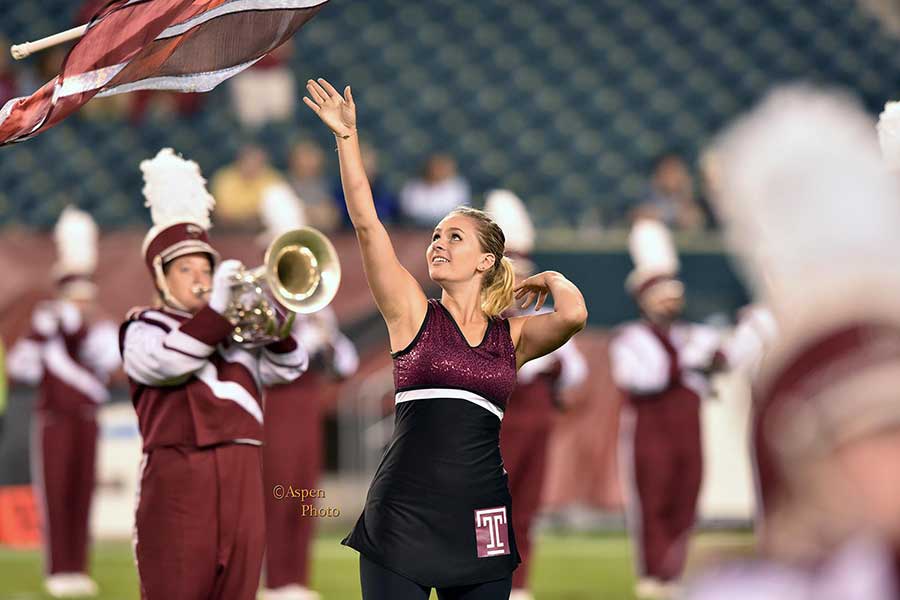Color guard: if you’ve heard of it at all, chances are you’ve heard the people involved dubbed the “reject cheerleaders,” or simply seen them with the band at football halftime shows. The guard is a team of people who use flags, sabres, rifles and dance to tell a story with music. In the band world, they’re dubbed “the auxiliary,” or simply referred to as the visual component of the show. As years have passed and guard has advanced, the “sport of the arts” has found other venues away from the band, creating its own community to showcase technical skill, athletic ability and artistry. While guard remains a cornerstone of half-time performances all over the country within marching bands, guards operating independently from scholastic programs can be found in regional and worldwide competitions as well as exhibition-only programs that participate in local events or parades.
I joined my high school’s color guard in 2013 while I was still in the closet. The person who was my captain that year was queer (and prefers the pronouns they/them). They took me under their wing from the moment I walked in. Although my coaches deserve all the credit for teaching me how to spin, it was my captain who first encouraged me to work on rifle, who invited me into their home on weekends and made me feel welcome on the field. It was through that same captain that I made many other queer friends and first became comfortable being out. Before I came out to either of my parents, guard was my cover to hang out with other gay kids, and eventually to begin dating my first girlfriend; since we were spinning together, it wasn’t weird for her to pick me up every weekend or for us to hang out for hours after school, and I felt safe exploring my sexuality without worrying what they would think.
Even as I struggled to accept my sexuality, color guard gave me something to strive for and a place to feel like I was part of a family by connecting me with people I knew would pick me up whenever I fell down. Through the worst and most traumatic experiences of my life, my coaches and fellow guard members have unconditionally supported me in a way I never found anywhere else. I’ve been lucky enough to make my closest friends and allies within this activity, as well as find my incredible partner, whom I would have never met outside of guard.
“Almost every color guard instructor I’ve ever had has been gay, and just seeing that made it feel like it was all right to be gay,” said Kay Peebles, a nonbinary pansexual who has been spinning since 2013. “I think guard was the first place I thought it was okay to be out, and then after that I could be out with anyone I knew, because if you’re out in front of crowds and crowds of people performing, it’s easier to be out in day-to-day life.”
As guard attracts more and more LGBT members, the shows themselves have come to reflect this growing population.
“Pennsauken had a soloist last year who put on a wig and he danced like a drag queen, because gay culture is very, very prominent in guard, in such that it gets written into shows and then you get to see them,” Peebles said. “In color guard, no matter what you do, it’s sort of like you don’t have to hide at all.”
Aside from just show themes, guards have even been founded with the express purpose of catering to minority groups. Jeff Shearer is both a coach and a performer for Light Brigade, a guard founded in 1976 and based in Philadelphia. “This activity has always been accepting to different diversities — LGBT, anything. There’s a trans woman who spins and every time I watch her, I can’t take my eyes off of her. But it’s not just the LGBT community — there are special-needs color guards, there are all different types of therapy color guards, it’s more than just LGBT. Anybody can do it.”
For those of you who attended Philadelphia Pride this year, you saw some of Light Brigade’s members spinning in the parade with the Flaggots, a guard that tours Pride parades in Pennsylvania, New Jersey and New York. Member Gerald Askins has spun with the organization for two years now. “You don’t have to be gay — you can be whomever. It brings the community and the world together because there are people on the team who are not gay and not lesbians — they’re straight and they support the community and support Pride.”
This is an activity that celebrates your personal identity, and to any person reading this who wants to try it out, I leave you with the advice of my coach, Jeff: “I’d say join; it welcomes you into a community of other gays, trans people, LGBT individuals. I say come, give it a shot, because it opens a door for you to express yourself.”
